Content
- 1 Quick reference of terms
- 2 The best varieties: how to choose cherries and not be disappointed
- 3 Classification
- 4 The best cherry varieties for the Moscow region
- 5 The best cherry varieties for the Urals with a photo
- 6 Cherry varieties for Siberia
- 7 The best cherry varieties for the Leningrad region
- 8 Cherry varieties for the Krasnodar Territory and southern regions
- 9 The best cherry varieties for the middle zone and the Chernozem region
- 10 Conclusion
Hundreds of existing cherry varieties are added with new ones every year. It is easy for even an experienced gardener to get confused in them. Cherry grows almost everywhere where there are fruit trees - in terms of demand and distribution, it is second only to the apple tree. To facilitate the selection of varieties, we offer a kind of guide. It is far from complete and is represented only by cherries created by breeders in Russia and neighboring countries.
Quick reference of terms
In articles devoted to cherries, there are often terms that we do not know or misunderstand the meaning of. We will try to explain them briefly. Probably, even advanced gardeners will not refuse a kind of cheat sheet. Of course, all this information can be easily found on the Internet, here they are simply collected together.
Pollination
Most often, the terms associated with the ability of cherries to set fruits from their own pollen are not quite correctly interpreted.
Self-fertility. Even in the absence of pollinators, cherries are capable of producing up to 50% of the possible yield.
Partial self-fertility. Without pollinating varieties, only 7 to 20% of the berries will be tied.
Self-infertility. In the absence of a variety suitable for pollination, cherry will give no more than 5% of the crop.
Entering fruiting
Compared to other crops (except peach), cherries begin to bear fruit early. The varieties are divided into three groups:
Fast-growing. The first crop is harvested in the third or fourth year after planting.
Medium-fruited. Fruiting - in the fourth year.
Late-fruited. Harvesting begins in the fifth or sixth year after planting.
Data are given for grafted varieties. Steppe cherry almost always begins to bear fruit earlier than ordinary cherry.
The period of full fruiting of cherries, depending on the variety, begins at 8-12 years of age.
Cherry sizes
By size, cherry varieties are also divided into three groups:
Stunted. A tree, or more often a bush, whose height does not exceed 2 m.
Medium-sized. The plant is 2-4 m high.
Tall. Cherry, the height of which reaches 6-7 m or more.
Plant size is not constant. With poor care, the cherry will be lower than the declared size, and with an excess of nitrogen fertilizers, it will be higher. And in fact, and in another case, the yield and quality of the fruits will suffer.
Harvest time
With this, everything seems to be clear. The varieties are:
Early ripe. Begins to bear fruit in late June - early July.
Mid-season. The crop is harvested in July.
Late ripening. Cherries ripen in August.
Remember, the further south the region is, the earlier the cherry ripens.
Purpose of fruits
Cherry varieties are divided into three groups:
Technical. Usually they have small sour berries with a high content of vitamins and other useful elements. Eating them fresh is a dubious pleasure. But these cherries make the best jams, juices, and wines.
Universal. Berries are suitable for processing and fresh consumption.
Canteens. They are often called dessert. The fruits are very beautiful and tasty, they contain a lot of sugar and little acid. Such cherries are good to eat fresh, but the processed products from them are mediocre. They are distinguished by a "flat" taste and weak aroma.
Cherry woody shape
The cultivated cherry is divided into two groups according to the shape of the plant:
Shrub. It combines steppe cherry and those ordinary varieties that grow in the form of a multi-stemmed low bush. Usually this group is more resistant to frost than the tree group. It bears fruit mainly on last year's shoots.
Tree-like. It combines most varieties of common cherries. Forms one trunk and bears fruit mostly on bouquet branches, less often on annual shoots. Drought-resistant.
Features of the fruit
Cherry fruits are divided into two unequal groups:
Morels or griots. The juice of most varieties of steppe and common cherries is colored deep red. It stains hands, has a pronounced aroma and sourness noticeable even in table varieties.
Amoreli. Cherry varieties with pink fruits and light juice. There are much fewer of them, they are sweeter.
A short dictionary of hybrids
Lately, many hybrids have been created. Last but not least, this is due to the desire to develop cherry varieties that are resistant to diseases and can withstand severe frosts. In addition, residents of cold regions do not give up the hope of getting cherries suitable for growing in the North into their gardens.
Duke. A hybrid of cherry and sweet cherry.
Cerapadus. A hybrid of cherry and bird cherry Maak, where the mother plant is cherry.
Padocerus. The result of crossing cherry with bird cherry, mother plant - bird cherry Maak.
The best varieties: how to choose cherries and not be disappointed
Often, amateur gardeners complain that their cherries do not bear fruit well, are often sick, and in general they are disillusioned with this culture. And the reason may be that they choose the wrong varieties.
- Plant only cherries that are specific to your region or regionalized. It would be a mistake to believe that southern varieties will not grow in the North, but on the contrary - easily. If you really decide to take a chance, take the trouble to go to the nursery for cherries. There is a golden rule of planting a "wrong" crop. If you want to grow a variety for a region farther south than yours, buy it from a nursery in the north and vice versa.
- Think about how your cherry will be pollinated. Even self-fertile varieties will give the best yield when cross-pollinated. For example, the famous Lyubskaya, depending on the region, gives an average of 12-15 or 25 kg per bush. But in the presence of "correct" pollinators, its yield can exceed 50 kg. Plant cherries in pairs, ask your neighbors what varieties they grow. The pollination radius is 40 m, which is not so small. As a last resort, plant a branch of the desired variety on the tree.
- Think carefully about which cherries to plant. Don't neglect technical varieties! The dining rooms look nice and it's a pleasure to eat them fresh. But the juice and jam from them are mediocre. Their taste is flat, "none". Have you ever wondered why only sweet cherries are not planted in Ukraine? It does not grow in every area. And try to find even a tiny courtyard without cherries, you will search for a long time. Sweet berries have been eaten and forgotten, but jam and juice will delight us until the next harvest, diversifying the diet and replenishing the lack of vitamins.
- Looking at the characteristics of cherries, correlate the yield with the habit of the plant.
- The size of the tree. Think carefully about what height cherry you will have "to the yard".6-7 kg of fruits collected from a two-meter tree or bush will all be eaten or processed. But the 7-meter cherry, which gives 60 kg of berries, will feed the birds, the caterpillar (it is difficult to process it), the crop will simply rot or dry out.
- Residents of the northern regions, do not chase early varieties! They usually bloom too early, it is difficult for them to escape from recurrent frosts and wait for the release of beneficial pollinating insects. It is better to get a decent harvest in two weeks or even a month than to admire the flowering annually and buy cherries on the market.
- Manure! It has nothing to do with varieties, but it cannot be ignored. The fact that cherries are very fond of manure is written in almost every article devoted to this culture. But we read it and happily forget it. But the famous Ukrainian cherry orchards began to decline not when coccomycosis began to rage, but much earlier! They lost most of their attractiveness and fertility when the cow became a rarity on the farm! If you want an exemplary cherry, ferment it!
Classification
Now we will briefly consider the features of the varieties of ordinary cherries, steppe and Bessei (sandy). You can read more about them in other articles on our site, as well as about varieties of felt cherries.
Most of the information can be obtained in the tables, where the culture is broken down by the timing of fruiting. Note:
- Varieties with other fruiting periods are often used as pollinators. This is due to the flowering time - for cherries, from the moment the buds open until the harvest, the timing varies.
- If the variety is intended for the southern regions and is frost-resistant there, one should not hope that it will withstand the low temperatures of the Urals or the Moscow region.
- The yield column often says “from the bush” or “from the tree”. This reflects the woody shape of the cherry.
- If you do not have the ability or desire to process plants after flowering, choose cherry varieties resistant to coccomycosis and moniliosis.
Early ripe cherry varieties
These cherry varieties are the first to bear fruit.
Variety name | Ripening period, month | Yield | Disease resistance | Characteristic (frost resistance, drought resistance) | Self-pollination (is it or not) | Pollinators |
Dessert Morozova | Mid june | About 20 kg per tree | High | Drought resistance - direct, frost resistance in the south - increased | Partially self-fertile | Griot Ostheimsky, Griot Rossoshansky, Vladimirskaya, Student |
Zherdevskaya Beauty | June | 107 c / ha | High | High | Partially self-fertile | Vladimirskaya, Lyubskaya |
Sap | End of June | 100 centners / ha | High | High | Self-sterile | Vianok, Novodvorskaya |
Dawn of the Volga region | End of June | Up to 12 kg per tree | High | High | Self-fertile | Any varieties of cherries |
Memory of Yenikeev | End of June | Up to 15 kg per tree | Average | Drought resistance good, frost resistance mediocre | Self-fertile | Lyubskaya, Surprise |
Gift for teachers | First days of July | 7-10 kg per tree | Average | High | Partially self-fertile | Other cherries blooming in mid-May |
Vocation (Rosinka, Samsonovka Melitopol) | End of June | Up to 28 kg per tree | High | Good in the south | Self-sterile | In memory of Yenikeev, Youth, Sania, Chocolate girl, Griot of Moscow, Baby (Saratov Baby) |
Saratov Baby (Baby) | End of June | Medium - 14.6 kg | High | High | Self-sterile | Nord Star, Turgenevka, Lyubskaya |
Cherry (Chereshenka) | June | Up to 15 kg | High | Average | Partially self-fertile | Kurchatovskaya, Troitskaya, Lighthouse, Lyubskaya |
Miracle (Miracle cherry) | End of June | Up to 10 kg | High | Low | Self-sterile | Cherries Donchanka, Household, Annushka, Little sister |
Spank Dwarf | End of June - beginning of July | Up to 35 kg | High | High | Partially self-fertile | Flaming, Brunette, Chocolate Girl |
Shpanka Bryanskaya | End of June - beginning of July | Up to 40 kg | High | High | Partially self-fertile | Griot Ostheim, Persistent, Griot Ukrainian, Chocolate girl, Dawn of Tataria, Lighthouse |
Shpanka Shimskaya | End of June - beginning of July | Up to 50 kg | High | High | Partially self-fertile | Chocolate Girl, Griot Ostheimsky, Lighthouse, Persistent |
Dessert Morozova
Zherdeevskaya Beauty
Memory of Yenikeev
Saratov Baby
Miracle
Spank Dwarf
Mid-season
The largest group. From mid-season varieties, you can choose cherries for every taste.
Variety name | Ripening period, month | Yield | Disease resistance | Characteristic (frost resistance, drought resistance) | Self-pollination (is it or not) | Pollinators |
Altai Swallow | End of july | 4-8.5 kg per bush | Average | High | Partially self-fertile | Zhelannaya, Subbotinskaya, Maskimovskaya, Selivestrovskaya |
Anthracite | Mid july | Up to 18 kg per tree | Average | Winter hardiness - good, drought resistance - mediocre | Partially self-fertile | Night, Vladimirskaya, Shubinka, Chocolate girl, Lyubskaya |
Assol | Early July | About 7 kg per tree | High | High | Self-fertile | Lyubskaya |
Biryusinka | July | Up to 20 kg per tree | High | High | Self-fertile | Ural Ruby |
Bogatyrka | July | 5-8 kg per bush | Average | High | Partially self-fertile | Lyubskaya, Troitskaya, Kurchatovskaya, Chereshenka |
Bolotovskaya | Early august | 8-11 kg per bush | Low | High | Self-fertile | Any varieties of cherries |
Brunette | End of july | 10-12 kg per tree | Average | Above average | Self-fertile | Lyubskaya |
Bulatnikovskaya | July | 10-12 kg per tree | To coccomycosis - good, to moniliosis - mediocre | Average | Self-fertile | Kharitonovskaya, Vladimirskaya, Zhukovskaya |
Bystrinka | Mid july | About 18 kg per tree | Average | High | Partially self-fertile | Vladimirskaya, Kharitonovka, Zhukovskaya, Morozovka |
Vladimirskaya | Mid july | In the middle lane - up to 25 kg per tree, in the Leningrad region - up to 5 kg | Low | Frost resistance of wood is good, flower buds are mediocre. Low drought tolerance | Self-sterile | Turgenevka, Amorel Pink, Griot Moscow, Lyubskaya, Consumer Black, Rustunya, Fertile Michurina, Lotovaya, Vasilievskaya |
Volochaevka | End of july | 12-15 kg per tree | High | Good frost resistance, mediocre drought resistance | Self-fertile | Griot Moscow, Generous, Lyubskaya |
A meeting | End of july | Up to 25 kg per tree | High | Good drought resistance, low frost resistance | Self-sterile | Minx, Somsonovka, Lyubskaya, Perceptible |
Vianok | Mid july | Up to 25 kg per tree | Average | High | Self-fertile | Lyubskaya |
Garland | In the south - at the end of June | Up to 25 kg per tree | To coccomycosis - mediocre, to moniliosis - good | Drought resistance - mediocre, frost resistance - good | Self-fertile | Any varieties of cherries |
Griot of Moscow | Mid to late July | 8-9 kg per tree | Average | Above average | Self-sterile | Vladimirskaya, Flask Pink |
Dessert Volzhskaya | Mid july | About 18 kg per tree | Average | Good winter hardiness, drought resistance - mediocre | Self-fertile | Ukrainka, Vladimirskaya, Dawn of the Volga region, Rastunya, Finaevskaya |
The desired | End of july | 7-12 kg per bush | Low | Average | Partially self-fertile | Altai Swallow, Maksimovskaya, Subbotinskaya, Selivertovskaya |
Zhukovskaya | Mid july | Up to 30 kg | High | Drought resistance is good, winter hardiness is mediocre | Self-sterile | Lyubskaya, Consumer goods Black, Vladimirskaya, Griot Ostgeimsky, Apukhinskaya, Youth |
Zagoryevskaya | End of July - beginning of August | 13-14 kg per tree | Average | Drought tolerance good, frost tolerance mediocre | Self-fertile | Lyubskaya, Shubinka, Vladimirskaya |
Star | July | Up to 20 kg per tree | Average | High | Partially self-fertile | Vianok, Seedling No. 1 |
Cinderella | Mid july | 10-15 kg per tree | High | High | Self-fertile | Lyubskaya |
Droplet | July | Up to 20 kg per tree | High | High | Self-fertile | Lyubskaya |
Nurse | First half of July | Highly dependent on the presence of pollinators | High | High | Self-sterile | Cherries Iput, Tyutchevka, Revna, Fatezh |
Lebedyanskaya | Second half of July | 7-8 kg per tree | High | Average | Self-sterile | Turgenevka, Vladimirskaya, Zhukovskaya, Morozovka |
Lighthouse | End of July - beginning of August | Depending on the region, from 5 to 15 kg per tree | Low | Good drought resistance, moderate frost resistance | Partially self-fertile | Generous, Vole |
Youth | End of july | 10-12 kg per tree | Average | Good | Self-fertile | Nord-Star, Lyubskaya, Vuzovskaya, Turgenevskaya, cherry |
Morozovka | Second half of July | Up to 15 kg per tree | High | High | Self-sterile | Griot Michurinsky, Lebedyanskaya, Zhukovskaya |
Mtsenskaya | End of july | 7-10 kg per tree | High | High | Self-fertile | Lyubskaya |
Hope | End of June - beginning of July | Average 21 kg per tree | High | In the recommended regions, good | Self-fertile | Any varieties of cherries |
Novella | Mid july | Average 15 kg per tree | High | Average | Partially self-fertile | Griot Ostheimsky, Vladimirskaya, Shokoladnitsa |
Novodvorskaya | Mid july | Up to 20 kg per tree | To coccomycosis - mediocre, to moniliosis - good | High | Partially self-fertile | Vianok, Seedling No. 1, Vladimirskaya, Lyubskaya |
Night | End of july | 10 kg per tree | High | High | Partially self-fertile | Youth, Lyubskaya, Nord Star, Meteor |
Ob | Mid to late July | 1.7-3.8 kg per bush | Low | High | Partially self-fertile | Altai Swallow, Subbotinskaya, Maksimovskaya |
Octave | Mid july | Up to 40 kg per tree | Average | Average | Partially self-fertile | Griot Moskovsky, Shokoladnitsa, Lyubskaya |
In memory of Mashkin | Mid july | On average 40 c / ha | Average | Average | Partially self-fertile | Lyubskaya |
Podbelskaya | Mid June - early July | Strongly depends on the place of cultivation, the average yield in the Krasnodar Territory is 12 kg, in the Crimea - 76 kg per tree | Average | Average | Self-sterile | English Early, Griot Ostheim, Lotova, Mei Duke, Anadolskaya |
Putinka | End of july | On average 80 c / ha | Average | Good | Partially self-fertile | Lyubskaya |
Radonezh (Radonezh) | Early July | On average 50 c / ha | High | High | Partially self-fertile | Vladimirskaya, Lyubskaya, Turgenevka |
Rossoshanskaya Black | End of June - beginning of July | About 15 kg per tree | Low | In the south - good | Partially self-fertile | Zhukovskaya, Vladimirskaya |
Spartan | Mid july | Up to 15 kg per tree | High | High | Self-sterile | Cherries and cherries with similar flowering times |
Troitskaya | Mid - end of July | 8-10 kg per tree | Average | Average | Partially self-fertile | Bogatyrskaya, Gradskaya, Standard of the Urals, Kurchatovskaya |
Turgenevka (Turgenevskaya) | Beginning - mid-July | 20-25 kg per tree | Average | Winter hardiness of wood is good, flower buds are mediocre, drought resistance is good | Partially self-fertile | Favorite, Lyubskaya, Youth, Griot Moskovsky |
Fairy | End of June | 10-12 kg per tree | High | Direct drought resistance, good winter hardiness in the south | Self-fertile | Lyubskaya, Turgenevka, Vladimirskaya |
Kharitonovskaya | Mid july | 15-20 kg per tree | High | Good resistance to drought, moderate to frost | Partially self-fertile | Zhukovskaya, Vladimirskaya |
Khutoryanka | End of June - beginning of July | 18-20 kg per tree | Medium to coccomycosis, high to moniliosis | High | Self-fertile | Lyubskaya |
Black Large | End of June | Average 15 kg per tree | Weak | Good in the south | Self-sterile | Kent, Griot Ostheim |
Blackcork | End of June - beginning of July | Depending on agricultural technology 30-60 kg | Weak | Good in the south | Self-sterile | Cherry Lyubskaya, cherries Donchanka, Aelita, Yaroslavna |
Minx | Second half of June | Up to 40 kg per tree | High | Good in the south | Self-sterile | Cherry Chernokorka, Samsonovka, Vinka cherry |
|
|
|
|
|
|
|
Consumer goods Black | Mid july | Up to 10 kg | Low | Average | Self-sterile | Rastunya, Lyubskaya, Vladimirskaya, Zhukovskaya, Griot Ostgeimsky |
Chocolate girl | First half of July | About 10 kg | Low | High | Self-fertile | Vladimirskaya, Flask Pink |
Generous (Maksimovskaya) | End of july | 4-8.4 kg per bush | High | High | Self-sterile | Altai Swallow, Zhelannaya, Subbotinskaya, Seliverstovskaya |
Altai Swallow
Anthracite
Biryusinka
Bolotovskaya
Brunette
Vladimirskaya
Garland
Dessert Volzhskaya
Zhukovskaya
Star
Nurse
Lighthouse
Mtsenskaya
Novella
Night
Podbelskaya
Rossoshanskaya Black
Turgenevka
Fairy
Kharitonovskaya
Chocolate girl
Late ripening
These cherry varieties are perfect for colder regions. They are guaranteed to get away from spring frosts.
Variety name | Ripening period, month | Yield | Disease resistance | Characteristic (frost resistance, drought resistance) | Self-pollination (is it or not) | Pollinators |
Ashinskaya (Alatyrskaya) | Mid august | 8-10 kg per tree | High | Average | Partially self-fertile | Ural Ruby, Abundant, Trans-Urals Dream |
Apukhtinskaya | August | about 20 kg per tree | High | Average | Self-fertile | Happiness, Youth, Lyubskaya |
Bessey | Since August | Up to 30 kg per bush | High | High | Self-sterile | Other varieties of sand cherry |
Brusnitsyna | August | Up to 20 kg per bush | High | High | Self-fertile | Lighthouse |
Winter Garnet | Mid august | Up to 10 kg per bush | High | High | Self-fertile | Sand cherry |
Igritskaya | August | Up to 25 kg per tree | High | High | Partially self-fertile | The same age, Abundant |
Lyubskaya | Depending on the region - from late July to mid-August | Depending on the region - from 10-12 to 25 kg per tree | Average | Average | Self-fertile | Vladimirskaya, Anadolskaya, Zhukovskaya, Fertile Michurina, Lotovaya |
Robin | Early august | Up to 15 t / ha | Medium to low | Good | Self-sterile | Shubinka, Vladimirskaya, Lyubskaya |
Dream of the Trans-Urals | Mid august | On average - 67 c / ha | Average | High | Self-fertile | Izobilnaya, Ural Ruby, Ashinskaya |
Michurinskaya | End of july | Up to 60 kg per tree | High | Average | Self-sterile | Cherries Michurinka, Pink Pearls |
Nord Star (Northstar) | Early to mid-August | 15-20 kg per tree | High | High | Partially self-fertile | Meteor, Nefris, Oblachinskaya |
Prima | End of july | 20-25 kg per tree | Average | High | Self-sterile | Shubinka, Zhukovskaya, Lyubskaya, Vladimirskaya |
Tamaris | End of July - beginning of August | About 10 kg per tree | High | High | Self-fertile | Turgenevka, Lyubskaya, Zhukovskaya |
Ural Ruby | Second half of August | 6-10 kg per bush | Average | High | Self-sterile | Alatyrskaya, Vole, Generous, Lighthouse, Zagrebinskaya |
Shubinka | Early august | Up to 18 kg | Average | High | Self-sterile | Lyubskaya, Griot Moscow, Consumer Black, Saika, Vladimirskaya |
Ashinskaya
Igritskaya
Lyubskaya
Dream of the Trans-Urals
Michurinskaya
Tamaris
Ural Ruby
Large-fruited varieties
The largest fruits are distinguished by dukes - hybrids with cherries, their size can reach 10 g. Usually large berries have a dessert taste. The largest-fruited:
- Turquoise;
- Bogatyrka;
- Brusnitsyna;
- A meeting;
- Garland;
- Zherdeevskaya Beauty;
- Zhukovskaya;
- Dawn of the Volga region;
- Nurse of the Moscow Region;
- Michurinskaya;
- Frosting;
- Hope;
- Night;
- Putinka;
- Saratov Baby;
- Spartan woman;
- Tamaris;
- Fairy;
- Kharitonovskaya;
- Black Large;
- Blackcork;
- Miracle;
- Minx;
- Spank Dwarf.
Self-pollinated varieties
Self-fertile varieties in small areas are especially popular. Even alone, they are able to give 40-50% of the possible harvest. Self-pollinated cherry varieties include:
- Assol;
- Apukhinskaya;
- Turquoise;
- Bolotovskaya;
- Brusnitsyna;
- Brunette;
- Bulatnikovskaya;
- Volochaevka;
- Vianok;
- Garland;
- Dessert Volzhskaya;
- Zagoryevskaya;
- Dawn of the Volga region;
- Winter Pomegranate;
- Cinderella;
- Droplet;
- Lyubskaya;
- Dream of the Trans-Urals;
- Youth;
- Mtsenskaya;
- Hope;
- Memory of Yenikeev;
- Tamaris;
- Fairy;
- Farmer;
- Chocolate girl.
Sweet cherry varieties
It's nice to eat sweet cherries straight from the tree in the summer. Especially carefully selected varieties are those with children growing up. Some of the sweetest include:
- Ashinskaya;
- Besseya;
- Turquoise;
- Bogatyrka;
- Bulatnikovskaya;
- Vladimirskaya;
- Volochaevka;
- A meeting;
- Garland;
- Dessert Morozova;
- Zherdyaevskaya Beauty;
- Sap;
- Zhukovskaya;
- Winter Pomegranate;
- Igritskaya;
- Nurse of the Moscow Region;
- Lighthouse;
- Frosting;
- Night;
- Octave;
- Memory of Yenikeev;
- In memory of Mashkin;
- Radonezh;
- Saratov Baby;
- Spartan woman;
- Tamaris;
- Fairy;
- Black Large;
- Blackcork;
- Miracle;
- Chocolate girl;
- Spunk.
Cherry and cherry hybrid
Sweet cherry grows only in the south, all efforts to regionalize it in cold regions have not yet been crowned with success. But even Ivan Michurin began to cross cherries and sweet cherries in Russia at the end of the 19th century. Dukes include:
- Bogatyrka;
- Bulatnikovskaya;
- Garland;
- Zhukovskaya;
- Nurse of the Moscow Region;
- Lighthouse;
- Michurinskaya;
- Hope;
- Night;
- Saratov Baby;
- Spartan woman;
- Fairy;
- Kharitonovskaya;
- Miracle;
- Consumer goods Black;
- Spunk.
It should be noted that thanks to the genes of the cherry, all these cherry varieties are resistant to moniliosis and coccomycosis.
Dwarf (undersized) cherry
Low varieties of cherries are especially appreciated in small summer cottages:
- Anthracite;
- Altai Swallow;
- Bolotovskaya;
- Bystrinka;
- Besseya;
- A meeting;
- Dawn of the Volga region;
- Winter Pomegranate;
- Lyubskaya;
- Lighthouse;
- Youth;
- Mtsenskaya;
- Ob;
- In memory of Mashkin;
- Vocation;
- Saratov Baby;
- Tamaris;
- Ural Ruby;
- Chocolate girl;
- Spank Dwarf;
- Generous (Maksimovskaya).
The best cherry varieties for the Moscow region
Today there are many cherries that are suitable for cultivation in the Central regions of Russia. It is best to choose varieties, the flowering time of which allows you to get away from spring frosts - medium and late fruiting.
Self-fertile varieties of cherries
Self-fertile varieties of cherries for the Moscow region quite enough. There are plenty to choose from:
- Assol;
- Apukhinskaya;
- Brunette;
- Bulatnikovskaya;
- Volochaevskaya;
- Cinderella;
- Lyubskaya;
- Mtsenskaya;
- Youth;
- Memory of Yenikeev;
- Tamaris;
- Chocolate girl.
Of course, in the Moscow region, you can grow self-fertile varieties intended for other, adjacent areas. We have provided a list of cherries bred specifically for the Central region.
Undersized
What sort of cherry is better to plant in the Moscow region in a small area? Of course, undersized. And if you graft 1-2 branches of a pollinator variety into it, you get a tree-garden in general. Among the small cherries suitable for cultivation in the Central Region, the following should be highlighted:
- Anthracite;
- Bystrinka;
- Winter Pomegranate;
- Lyubskaya;
- Youth;
- Mtsenskaya;
- Lighthouse;
- In memory of Mashkin;
- Saratov Baby;
- Tamaris;
- Chocolate girl;
- Spank Dwarf.
Sweet
Residents of the Moscow region pay special attention to varieties with a dessert taste. Not many cherries can pick up enough sugar in cooler climates. You should pay attention to the following varieties:
- Ashinskaya;
- Bulatnikovskaya;
- Vladimirskaya;
- Volochaevskaya;
- Griot of Moscow;
- Sap;
- Zhukovskaya;
- Winter Pomegranate;
- Igritskaya;
- Nurse of the Moscow Region;
- Lighthouse;
- Frosting;
- Michurinskaya;
- Octave;
- In memory of Mashkin;
- Memory of Yenikeev;
- Radonezh;
- Saratov Baby;
- Spartan woman;
- Tamaris;
- Dwarf spank;
- Shpanka Bryanskaya;
- Chocolate girl.
The best cherry varieties for the Urals with a photo
The harsh climate of the Urals with an uneven distribution of precipitation requires particularly careful selection of varieties. We recommend paying attention to the following cherries:
- Altai Swallow;
- Ashinskaya;
- Besseya;
- Turquoise;
- Bogatyrka;
- Bolotovskaya;
- Brusnitsyna;
- Vladimirskaya;
- Dessert Volzhskaya;
- Lyubskaya;
- Robin;
- Dream of the Trans-Urals;
- Mtsenskaya;
- Ob;
- Troitskaya;
- Ural Ruby;
- Shpanka Shimskaya;
- Generous (Maksimovskaya).
Cherry varieties for Siberia
Only medium and late ripening varieties are suitable for growing in Siberia. Most often, steppe cherry cultivars are planted there, better tolerating the vagaries of changeable weather. It is worth paying attention to Besseya (sandy). Unfortunately, in Russia so far little attention is paid to this cherry, and the North American varieties have not been tested in our country.
In Siberia, the following are grown:
- Altai Swallow;
- Besseya;
- Turquoise;
- Vladimirskaya;
- Zherdyaevskaya Beauty;
- Desired;
- Lyubskaya;
- Ob;
- Ural Ruby;
- Shubinka;
- Chocolate girl;
- Shpanka Shimskaya;
- Generous (Maksimovskaya).
The best cherry varieties for the Leningrad region
It is difficult to grow cherries in the Northwest. But every year new varieties appear - this region is densely populated, fruit crops are in demand. In the Leningrad region, you can grow:
- Altai Swallow;
- Besseya;
- Vladimirskaya;
- Zherdyaevskaya Beauty;
- Desired;
- Star;
- Lyubskaya;
- Frosting;
- Shubinka;
- Ural Ruby.
Cherry varieties for the Krasnodar Territory and southern regions
A large selection of cherries from residents of warm regions. Large-fruited and sweet dukes grow well there, varieties of any ripening period, including early ones. It is worth paying attention to cultivars that tolerate heat and drought well. Cherry varieties for the Krasnodar Territory and southern regions:
- Ashinskaya;
- A meeting;
- Garland;
- Droplet;
- Lyubskaya;
- Frosting;
- Hope;
- Novella;
- Night;
- Podbelskaya;
- Vocation;
- Prima;
- Rossoshanskaya;
- Tamaris;
- Turgenevka;
- Fairy;
- Kharitonovka;
- Farmer;
- Blackcork;
- Black Large;
- Miracle;
- Minx;
- Spunk.
The best cherry varieties for the middle zone and the Chernozem region
Cherry feels comfortable in central Russia. It grows well on black soil at moderate temperatures throughout the year. You should pay attention to the varieties:
- Anthracite;
- Bystrinka;
- Vladimirskaya;
- Griot of Moscow;
- Dessert Morozova;
- Zherdeevskaya Beauty;
- Zhukovskaya;
- Zhivitsa;
- Igritskaya;
- Lebedyanskaya;
- Robin;
- Frosting;
- Novella;
- In memory of Mashkin;
- Gift for Teachers;
- Podbelskaya;
- Putinka;
- Rossoshanskaya;
- Radonezh;
- Spartan woman;
- Turgenevka;
- Kharitonovskaya;
- Cherry;
- Black Large;
- Shubinka;
- Shpanka Bryanskaya.
I would like to highlight separately self-fertile varieties of cherries for the middle lane:
- Assol;
- Brunette;
- Bulatnikovskaya;
- Volochaevka;
- Dessert Volzhskaya;
- Droplet;
- Lyubskaya;
- Mtsenskaya;
- Youth;
- Mtsenskaya;
- Youth;
- Hope;
- Memory of Yenikeev;
- Tamaris;
- Fairy;
- Farmer;
- Chocolate girl.
Conclusion
As you can see, there are many varieties of cherries, everyone can find exactly what they need. We hope that our article and the photos posted in it will help you with your choice.
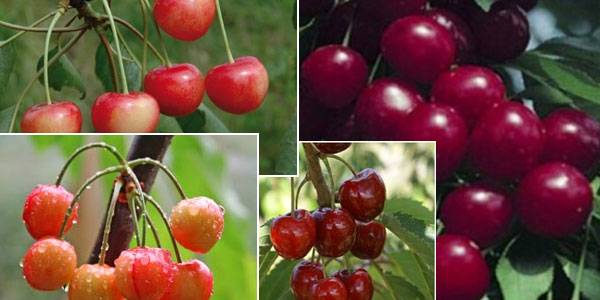
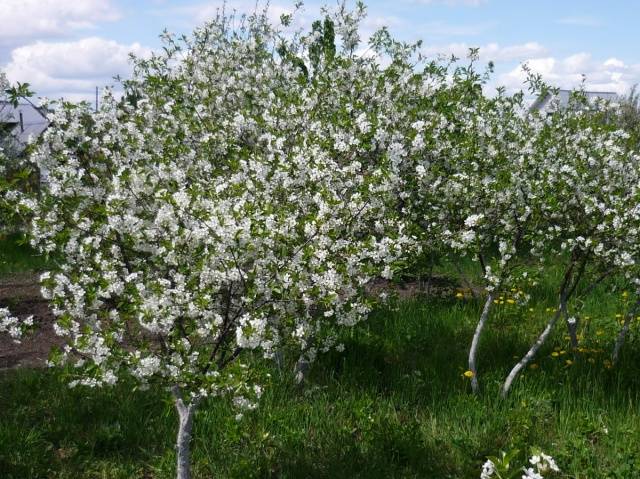
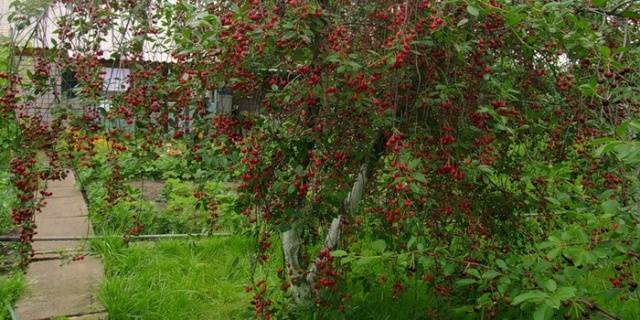
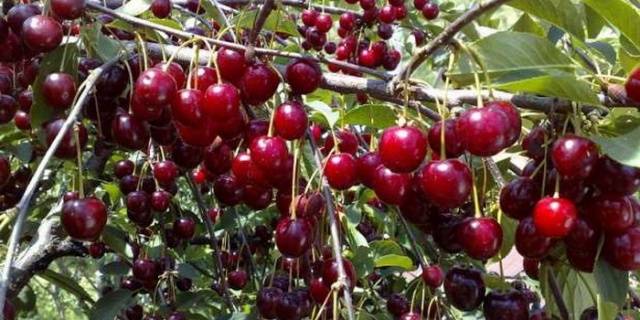
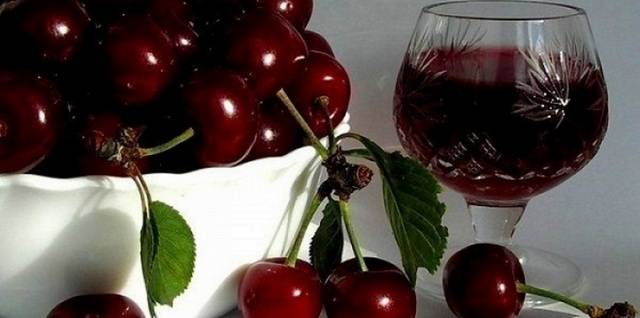
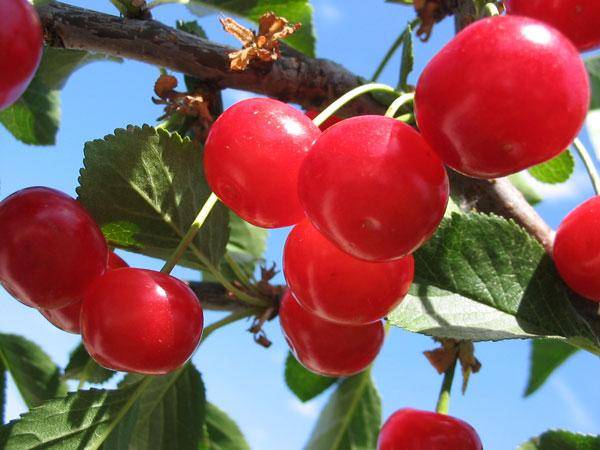

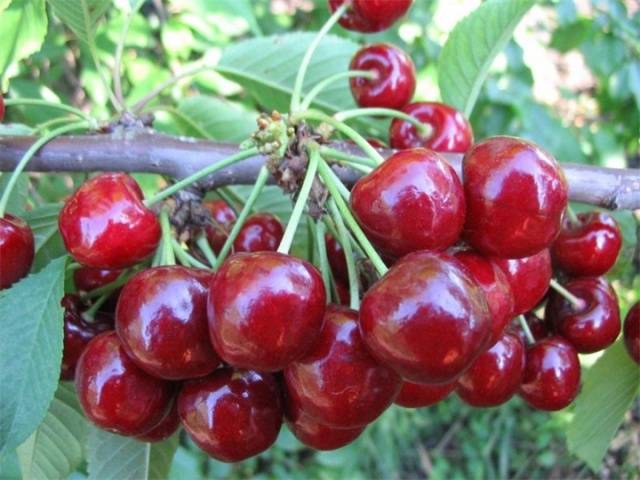

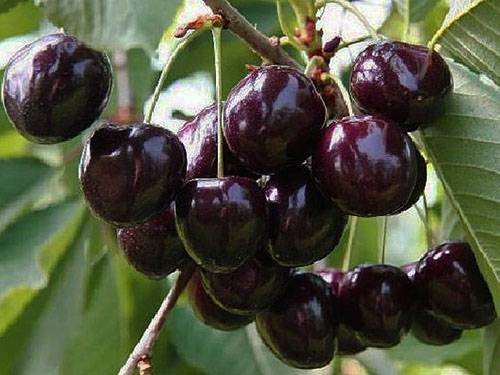
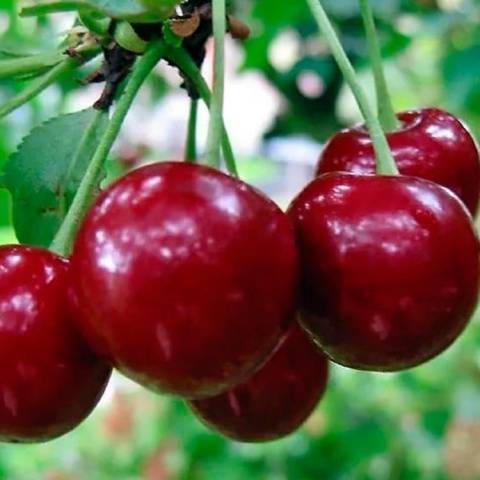

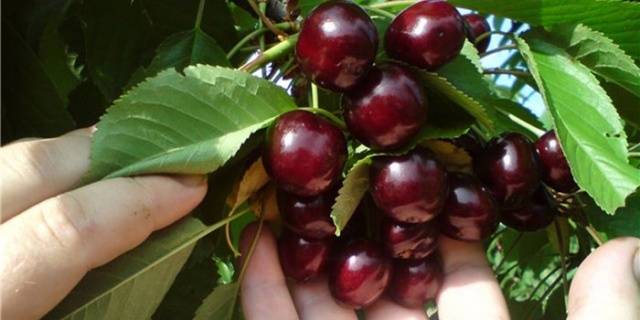
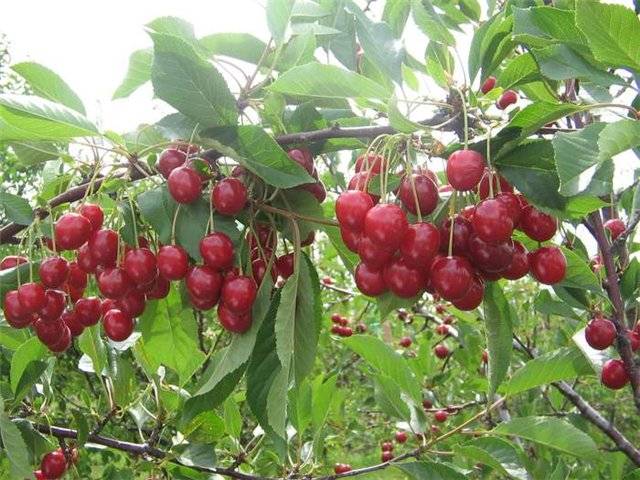


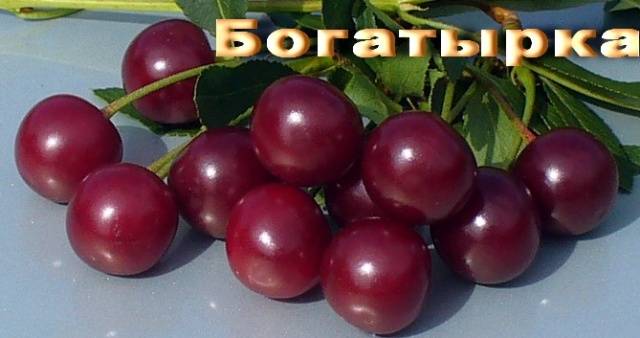
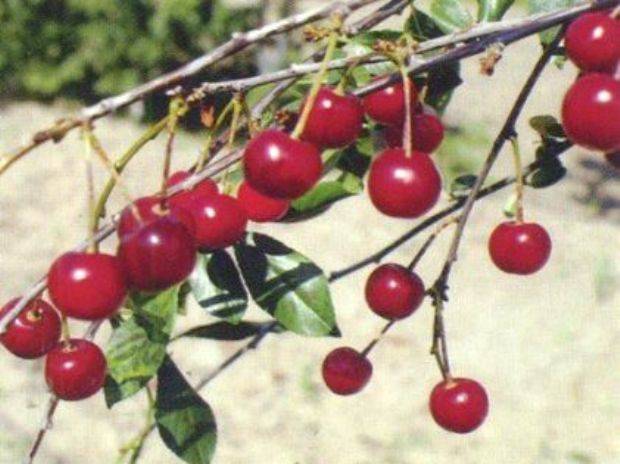
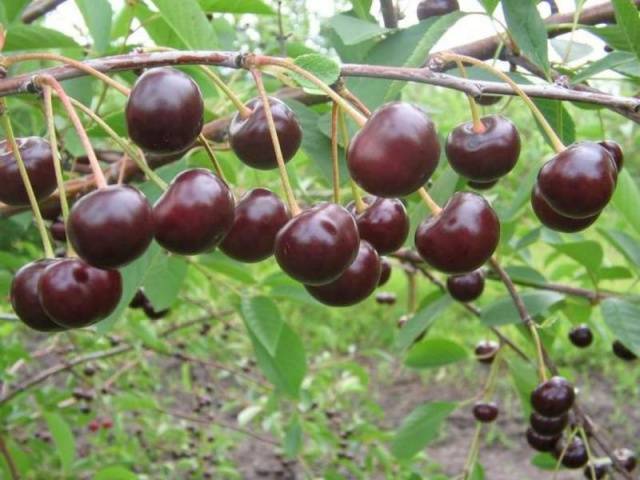
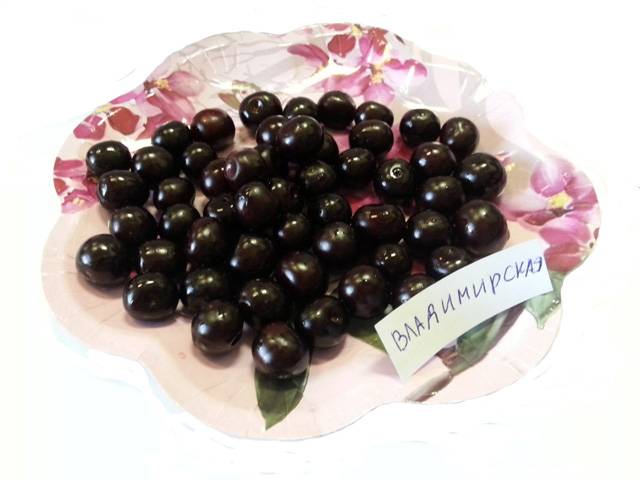
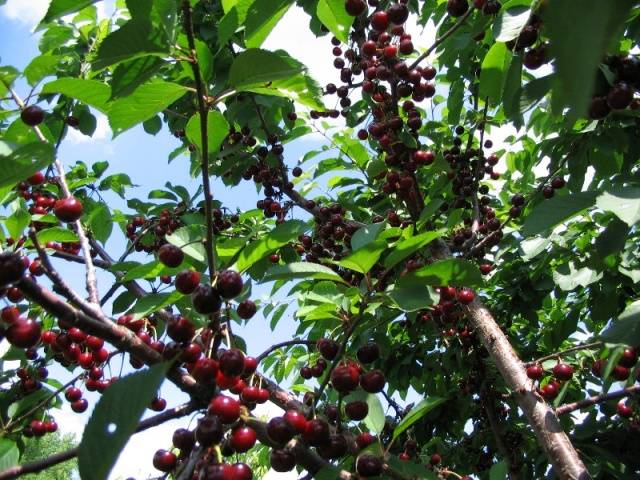
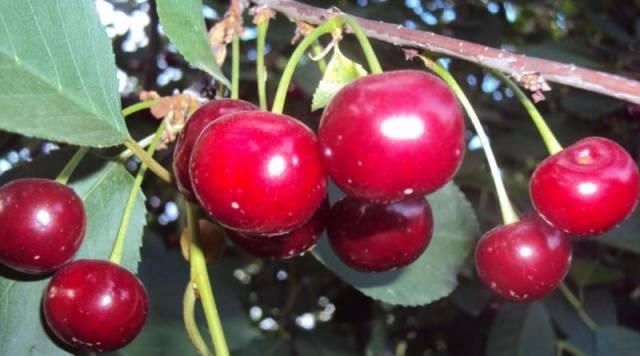

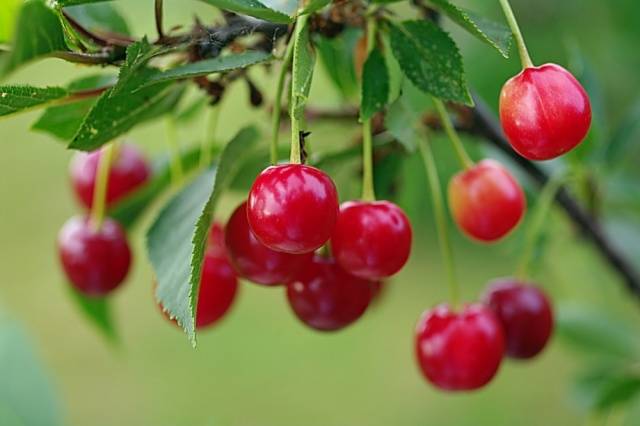
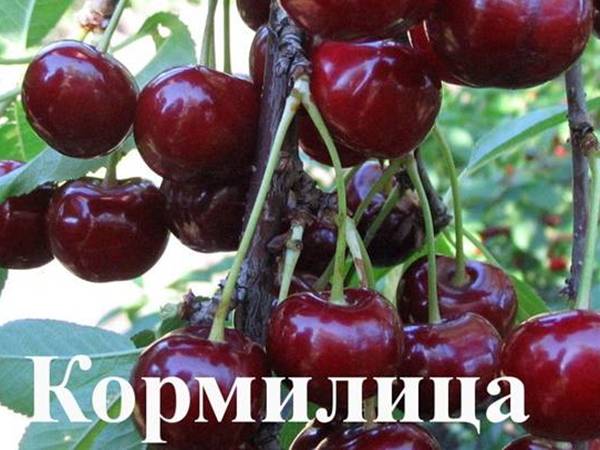
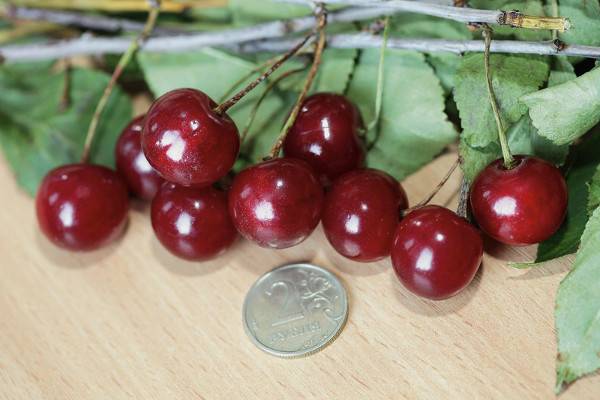

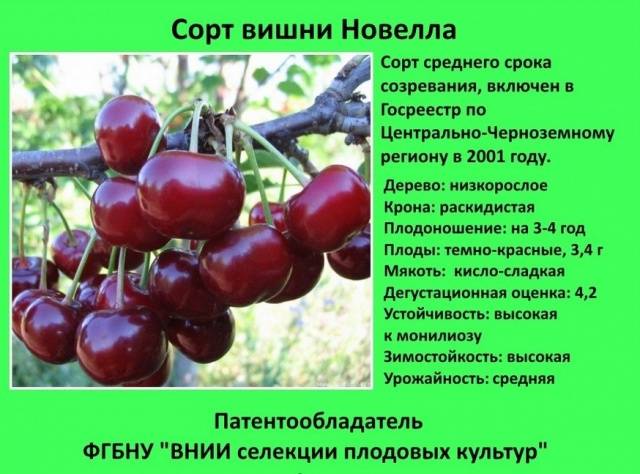
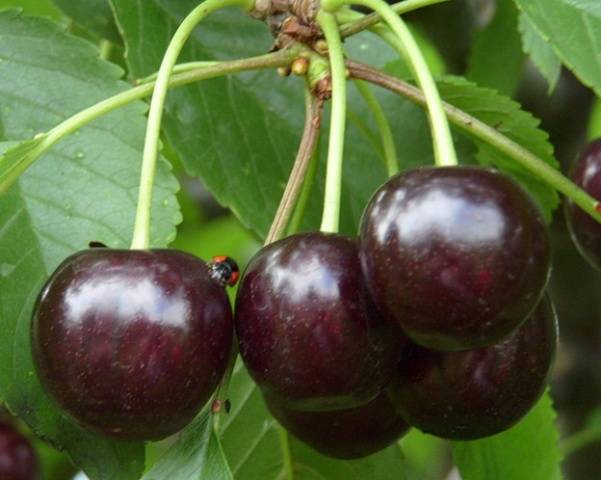
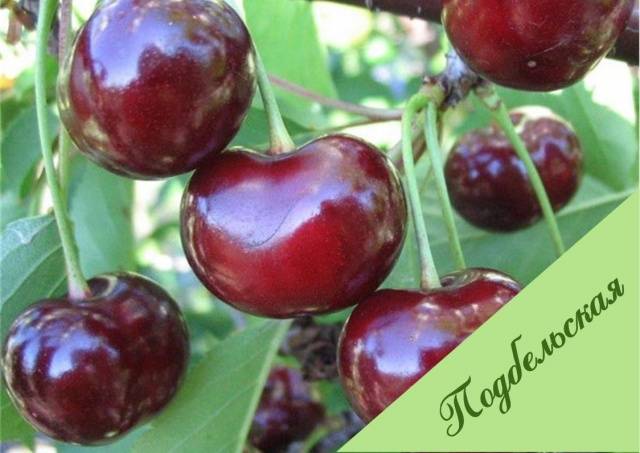
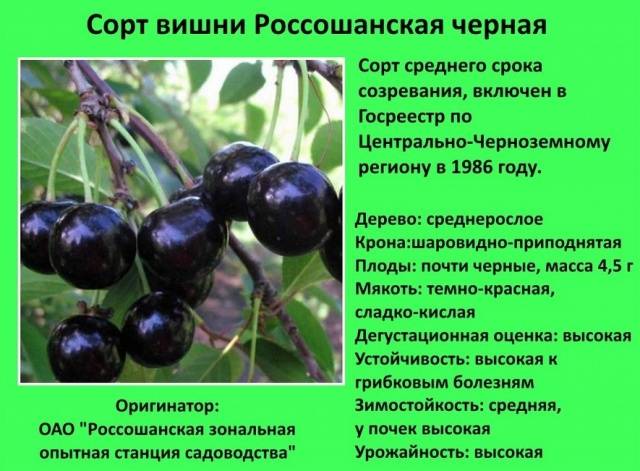

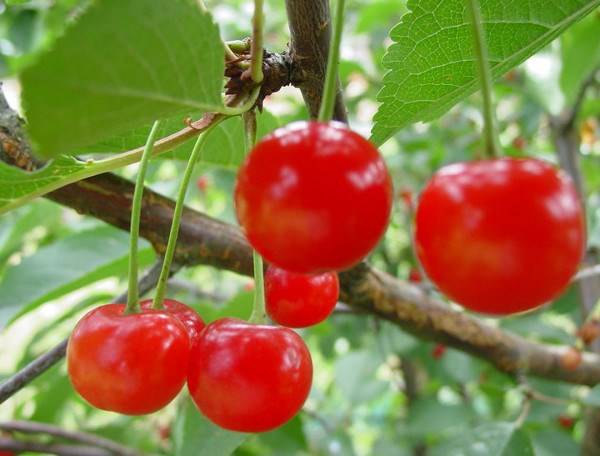

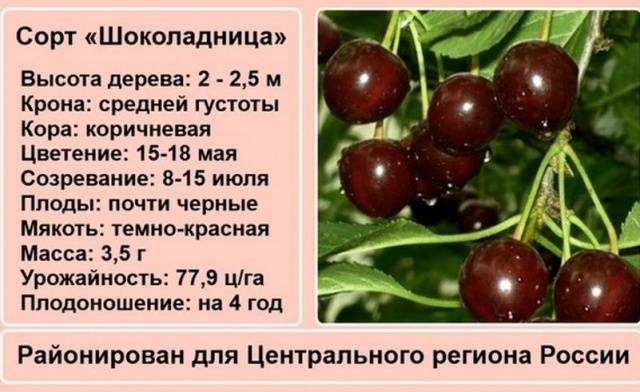
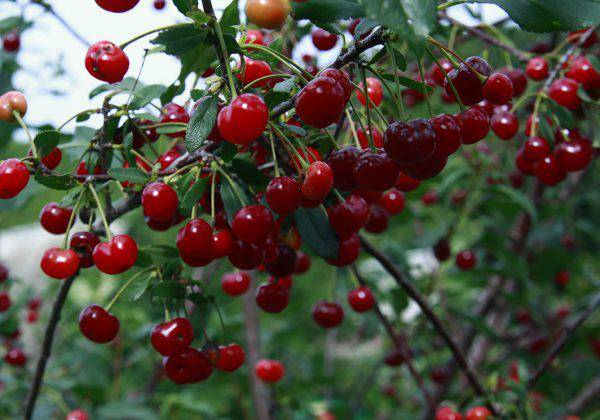

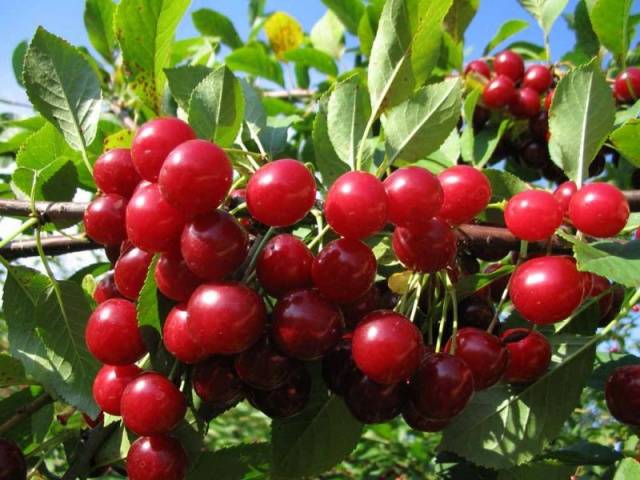
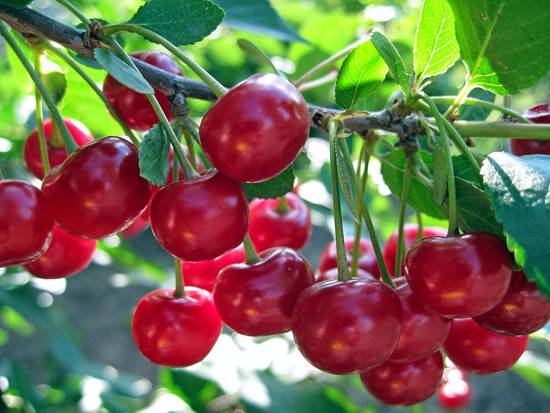
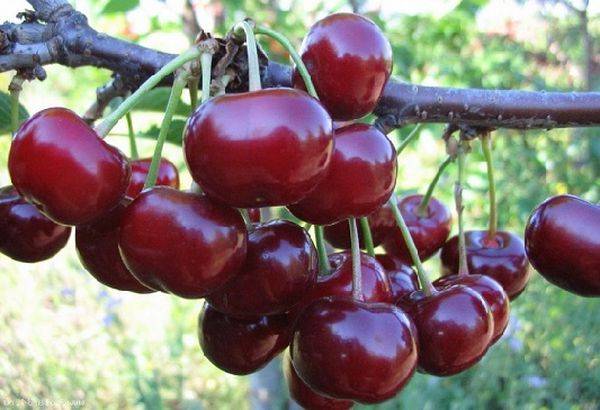
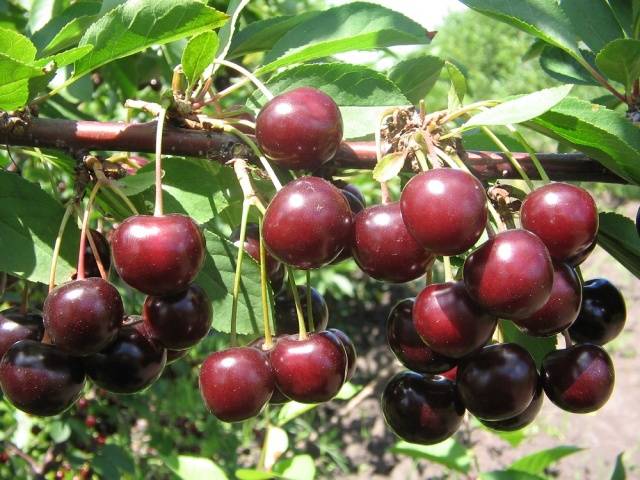

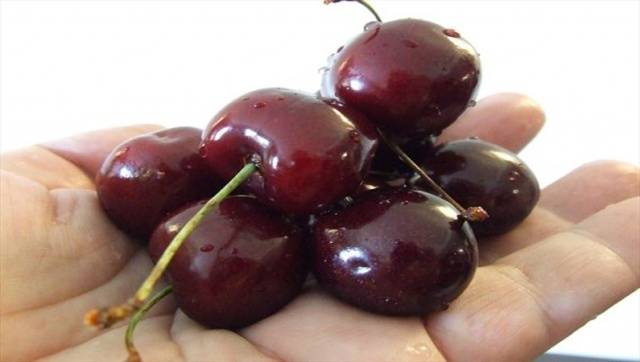
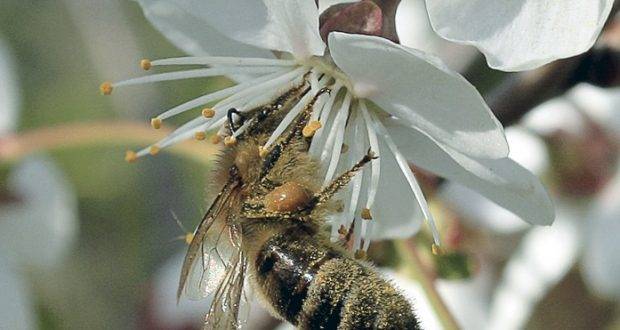

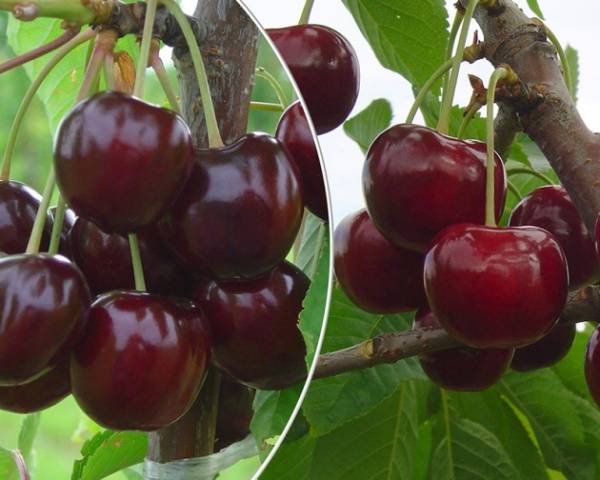
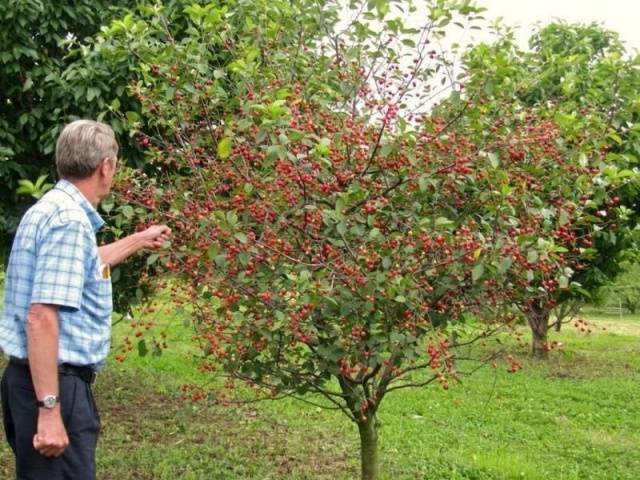

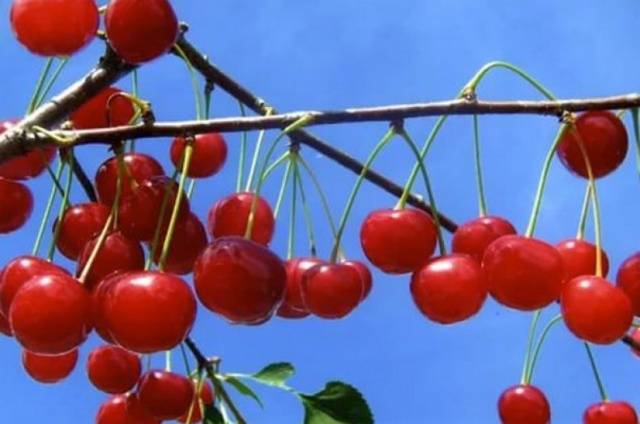
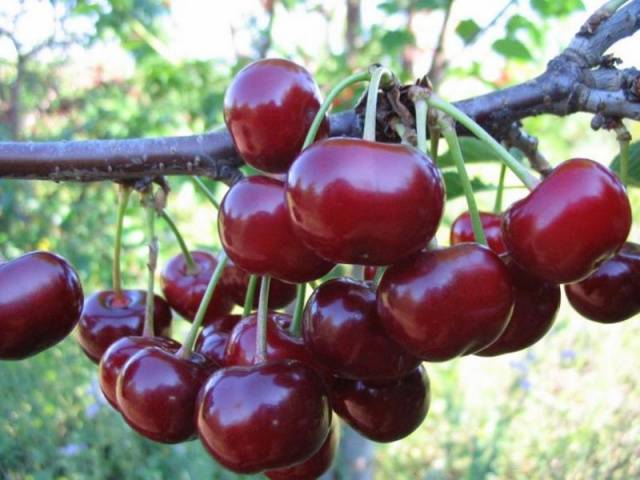
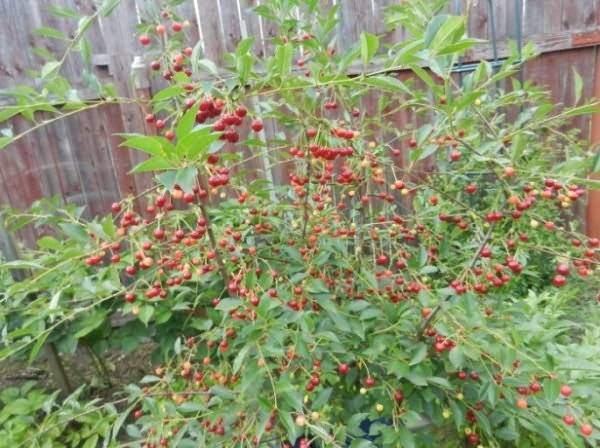
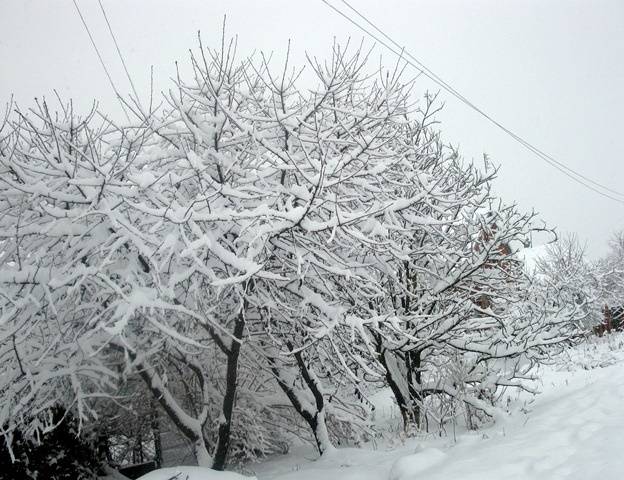
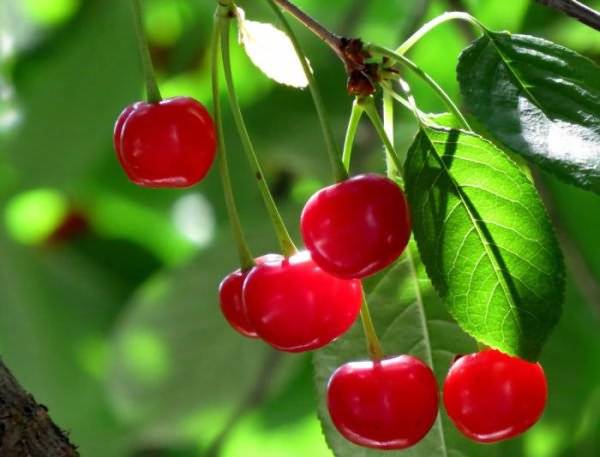
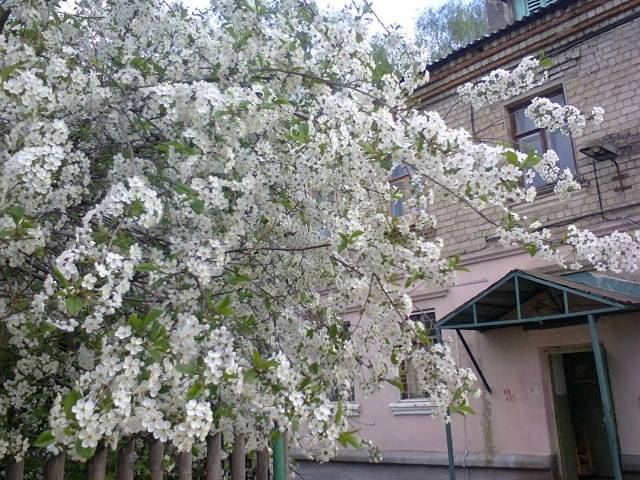
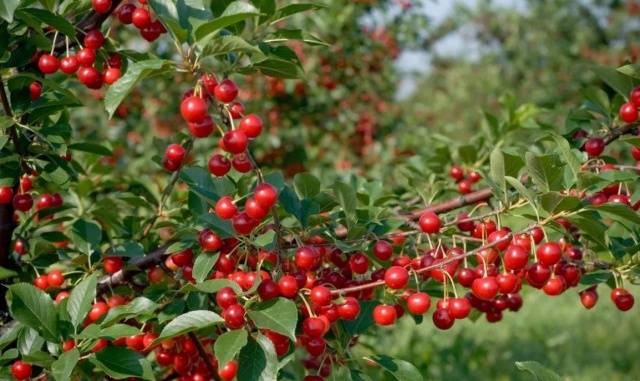









Thank you so much for your work! Very useful article. THANKS !!!